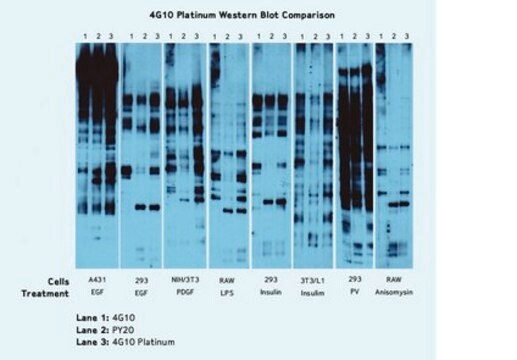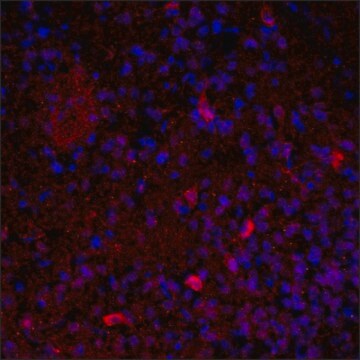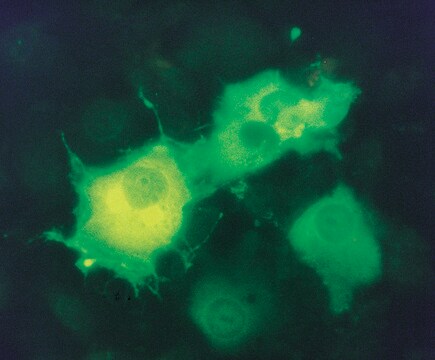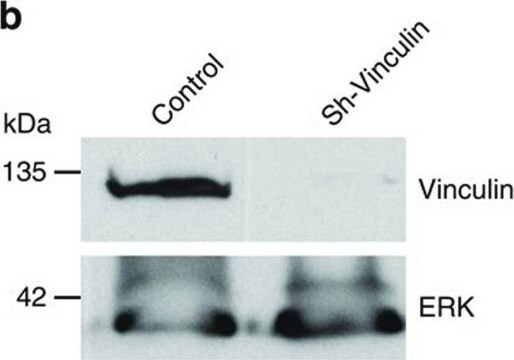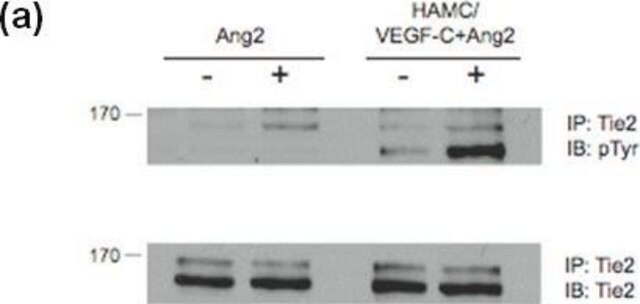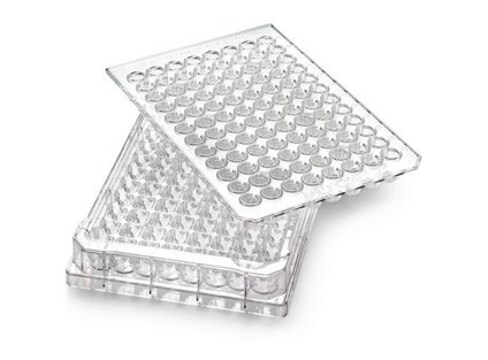05-584
Anti-Tie2/TEK Antibody, clone Ab33
clone Ab33, Upstate®, from mouse
동의어(들):
CD202b antigen, TEK tyrosine kinase, endothelial, Tunica interna endothelial cell kinase, Tyrosine-protein kinase receptor TEK, Tyrosine-protein kinase receptor TIE-2, p140 TEK, soluble TIE2 variant 1, soluble TIE2 variant 2, venous malformations, multip
로그인조직 및 계약 가격 보기
모든 사진(1)
About This Item
UNSPSC 코드:
12352203
eCl@ss:
32160702
NACRES:
NA.41
추천 제품
생물학적 소스
mouse
Quality Level
항체 형태
purified immunoglobulin
항체 생산 유형
primary antibodies
클론
Ab33, monoclonal
종 반응성
human, rat, pig, mouse
제조업체/상표
Upstate®
기술
immunohistochemistry: suitable
immunoprecipitation (IP): suitable
western blot: suitable
동형
IgG1κ
NCBI 수납 번호
UniProt 수납 번호
배송 상태
wet ice
타겟 번역 후 변형
unmodified
유전자 정보
human ... TEK(7010)
일반 설명
TIE2 (tyrosine kinase with Ig and EGF homology domains 2) is expressed almost exclusively in endothelial cells in mice, rats and humans. This receptor possesses a unique extracellular domain containing two immunoglobulin-like loops separated by three epidermal growth factor-like repeats that are connected to three fibronectin type III-like repeats. The ligand for the receptor is Angiopoietin 1. Defects in TIE2 are associated with inherited venous malformations; the TIE2 signaling pathway appears to be critical for endothelial cell-smooth muscle cell communication in venous morphogenesis.
특이성
Recognizes Tie2/TEK, Mr 145kDa
면역원
Fusion protein corresponding to residues 1-745 of human Tie2/TEK with a C-terminal His6-tag purified from infected SF-9 cells. Clone Ab33
애플리케이션
Immunoprecipitation: This antibody immunoprecipitated Tie2/TEK, as reported by an independent laboratory.
Immunohistochemistry: Reported to detect Tie2/TEK in frozen, Triton-treated sections.
This antibody is not suitable for paraffin-embedded sections.
Immunohistochemistry: Reported to detect Tie2/TEK in frozen, Triton-treated sections.
This antibody is not suitable for paraffin-embedded sections.
This Anti-Tie2/TEK Antibody, clone Ab33 is validated for use in WB, IP, IH for the detection of Tie2/TEK.
품질
Evaluated by western blot on RIPA lysates from HUVEC cells.
Western Blot Analysis: 0.2-1 μg/mL of this antibody detected Tie2/TEK in RIPA lysates from HUVEC cells.
Western Blot Analysis: 0.2-1 μg/mL of this antibody detected Tie2/TEK in RIPA lysates from HUVEC cells.
표적 설명
145 kDa
물리적 형태
Format: Purified
Purified mouse monoclonal IgG1κ in buffer containing 0.1 M Tris-glycine, pH 7.4, 0.15 M NaCl, 0.05% sodium azide before the addition of glycerol to 30%. Liquid at -20°C.
기타 정보
Concentration: Please refer to the Certificate of Analysis for the lot-specific concentration.
법적 정보
UPSTATE is a registered trademark of Merck KGaA, Darmstadt, Germany
적합한 제품을 찾을 수 없으신가요?
당사의 제품 선택기 도구.을(를) 시도해 보세요.
Storage Class Code
10 - Combustible liquids
WGK
WGK 1
시험 성적서(COA)
제품의 로트/배치 번호를 입력하여 시험 성적서(COA)을 검색하십시오. 로트 및 배치 번호는 제품 라벨에 있는 ‘로트’ 또는 ‘배치’라는 용어 뒤에서 찾을 수 있습니다.
Mary Anna Venneri et al.
Blood, 109(12), 5276-5285 (2007-03-01)
Tumor-infiltrating myeloid cells, including tumor-associated macrophages (TAMs), have been implicated in tumor progression. We recently described a lineage of mouse monocytes characterized by expression of the Tie2 angiopoietin receptor and required for the vascularization and growth of several tumor models.
Daisuke Sakai et al.
JOR spine, 1(2), e1018-e1018 (2018-06-27)
Recently, Tie2/TEK receptor tyrosine kinase (Tie2 or syn. angiopoietin-1 receptor) positive nucleus pulposus progenitor cells were detected in human, cattle, and mouse. These cells show remarkable multilineage differentiation capacity and direct correlation with intervertebral disc (IVD) degeneration and are therefore
Haixia Gong et al.
Scientific reports, 7, 42127-42127 (2017-02-16)
Human endothelial cells (ECs) are widely used to study mechanisms of angiogenesis, inflammation, and endothelial permeability. Targeted gene disruption induced by Clustered Regularly Interspaced Short Palindromic Repeats (CRISPR)-CRISPR-Associated Protein 9 (Cas9) nuclease gene editing is potentially an important tool for
Hiroko Fujii et al.
Arteriosclerosis, thrombosis, and vascular biology, 26(11), 2476-2482 (2006-08-26)
C-reactive protein (CRP) has been suggested to participate in the development of atherosclerosis, in part, by promoting endothelial dysfunction and impairing endothelial progenitor cell (EPC) survival and differentiation. In the present study, we evaluated the effects of CRP on antioxidative
Delivery of therapeutic siRNA to the lung endothelium via novel Lipoplex formulation DACC.
Fehring, V; Schaeper, U; Ahrens, K; Santel, A; Keil, O; Eisermann, M; Giese, K; Kaufmann, J
Molecular Therapy null
자사의 과학자팀은 생명 과학, 재료 과학, 화학 합성, 크로마토그래피, 분석 및 기타 많은 영역을 포함한 모든 과학 분야에 경험이 있습니다..
고객지원팀으로 연락바랍니다.